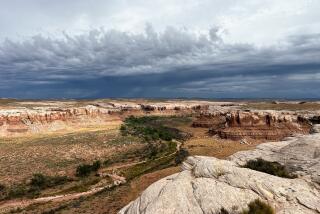Federal officials travel to California to reach out to off-roaders
Reporting from Imperial Sand Dunes Recreation Area — Freed from the confines of Washington, Interior Secretary Ken Salazar on Sunday kicked up his heels in the California desert, where he raced across undulating dunes in a souped-up sand rail.
And, perhaps as a reminder of the gridlock he left behind on Capitol Hill, Salazar’s vehicle became mired in the sand as he attempted to surmount a steep dune.
The daredevil antics were driven by a serious intent: to reach out to a constituency often antagonistic to federal officials and their management of public lands in the West. To that end, Salazar and Bob Abbey, director of the Bureau of Land Management, toured Imperial Sand Dunes Recreation Area on a busy holiday weekend.
The pair came to mend political fences by stressing that motorized recreation fits into the Obama administration’s vision of America’s Great Outdoors, a conservation and health initiative rolled out last week that is heavy on land preservation.
“When we talk about the great outdoors, this is the kind of recreation we are talking about, “ Salazar told a group of off-road enthusiasts, raising his voice to be heard above the deep rumbles and high-pitched whines coming from fleets of “sand toys” racing past near the town of Glamis.
That message of inclusion is seldom heard here, a 160,000-acre BLM-managed recreation area for Jeepers, dirt bike riders and dune buggy drivers. Also known as Algodones Dunes, the area for years has been the focal point of legal wrangling between off-roaders seeking to keep acreage open and environmentalists demanding protection of the dunes’ sensitive plant and animal species.
The Imperial Sand Dunes also carry the lingering reputation as one of the most dangerous off-road recreation areas in the United States. Thanksgiving weekend gatherings draw more than 200,000 people and have led to homicides, traffic fatalities and mass arrests.
Bill Jones, president of the American Desert Foundation, which promotes safe and environmentally conscious off-roading, said the “criminal element” that used to run roughshod has been largely driven out.
“There were just a bunch of guys out here who thought laws didn’t apply to them,” Jones said. “There were areas that were very dangerous. It made families stay away.”
Even so, with an estimated 85,000 revelers over the Presidents Day weekend, officials said, there were multiple medical emergencies — a few requiring helicopter evacuation— and arrests for disorderly conduct and driving under the influence.
Still, it was a far cry from Thanksgiving 2001, when two people were killed in separate crashes, one person was shot to death and a park ranger suffered minor injuries when he was run over. There were 70 arrests and 200 medical emergencies at that event.
The 200 square miles of sculpted bowls and sandy flats draws 1.3 million visitors a year, a significant economic engine in struggling Imperial County. That brought local officials out on a cold and blustery day to buttonhole Salazar and Abbey for more funds to better manage the vast area, which on busy weekends is patrolled by federal and county law enforcement.
“I compare this to Yellowstone” National Park, said Jack Terrazas, chairman of the county Board of Supervisors. “We have 25% of their visitation but only 3% of their budget.”
Salazar urged the officials to speak to their congressional delegation, explaining that the BLM’s budget and other conservation and recreation funding sources were under assault from Republican cost-cutters in the House of Representatives.
The group remained noncommittal but gave Salazar credit for making the trip to the middle of the desert.
“If they are sincere, then that’s great news,” said Bon Ham, Imperial County’s chief lobbyist. “But I’ve read the America’s Great Outdoors plan, and I have to tell you, there’s not much in it about motorized recreation.”
More to Read
Sign up for Essential California
The most important California stories and recommendations in your inbox every morning.
You may occasionally receive promotional content from the Los Angeles Times.











